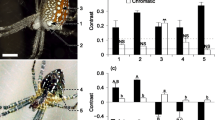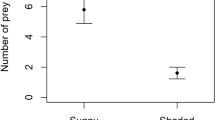Abstract
Many orb-weaving spiders decorate their webs with conspicuous ultraviolet (UV)-reflective stabilimenta. The prey-attraction hypothesis suggests that stabilimenta are visually attractive to prey and thus may increase the spiders’ foraging success. However, previous studies on the function of stabilimenta have produced conflicting results in Argiope species. Using a combination of field and laboratory studies, we examined whether the linear stabilimentum of Argiope bruennichi contributes to prey interception. We recorded prey interceptions in 53 webs with stabilimenta and 37 equally-sized webs without stabilimenta, classifying captured prey according to their taxonomical group and size. On average, 6.2 ± 4.7 prey items were intercepted in webs with stabilimenta, while 3.2 ± 2.9 items were intercepted in webs without stabilimenta. The effects of stabilimenta on foraging success appear to be due to increased interception of UV-sensitive insect pollinators, including 20 families of Diptera, Hymenoptera, Coleoptera, and Lepidoptera. The mean number of UV-sensitive prey was 4.4 ± 3.6 in webs with stabilimenta compared with 1.8 ± 2.1 in webs without stabilimenta. Webs with and without stabilimenta did not differ in the mean number of UV-nonsensitive prey captured. The linear stabilimentum showed strong positive effects on the interception of large prey: webs with stabilimenta captured more than twice as many large prey (≥5 mm) than webs without stabilimenta, whereas there was only a slight difference in the interception rates for small prey (<5 mm). Comparisons among different Argiope species suggest that the stabilimentum may have different adaptive functions in different species or ecological contexts.





Similar content being viewed by others
References
Adamat LA, Torres MAT, Gorospe JA, Barrion-Dupo ALA, Demayo CG (2011) Orb-web design of garden spider, Argiope appensa (Walckenaer, 1841) (Araneae: Araneidae). Aust J Basic Appl Sci 5:175–184
Blackledge TA (1998) Stabilimentum variation and foraging success in Argiope aurantia and Argiope trifasciata (Araneae, Araneidae). J Zool 246:21–27
Blackledge TA, Wenzel JW (2000) The evolution of cryptic spider silk: a behavioral test. Behav Ecol 11:142–145
Bruce MJ (2006) Silk decorations: controversy and consensus. J Zool 269:89–97
Bruce MJ, Herberstein ME, Elgar MA (2001) Signalling conflict between prey and predator attraction. J Evol Biol 14:786–794
Bruce MJ, Heiling AM, Herberstein ME (2004) Web decorations and foraging success in Araneus eburnus (Araneae: Araneidae). Ann Zool Fennici 41:563–575
Craig CL, Bernard GD (1990) Insect attraction to ultraviolet reflecting spider webs and web decorations. Ecol 71:616–623
Crome W, Crome I (1961) Paarung und Eiablage bei Argiope bruennichi (Scopoli) auf Grund von Freilandbeobachtungen an zwei Populationen im Spreewald/Mark Brandenburg (Araneae: Araneidae). Mitt Zool Mus Berlin 37:189–252
Eberhard WG (1973) Stabilimenta on the webs of Uloborus diversus (Araneae: Uloboridae) and other spiders. J Zool Lond 171:367–384
Eberhard WG (2003) Substitution of silk stabilimenta for egg sacs by Allocyclosa bifurca (Araneae: Araneidae) suggests that silk stabilimenta function as camouflage devices. Behaviour 140:847–868
Eisner T, Nowicki S (1983) Spider web protection through visual advertisement: role of the stabilimentum. Science 219:185–187
Elgar MA, Allan RA, Evans TA (1996) Foraging strategies in orb-spinning spiders: ambient light and silk decorations in Argiope aetherea Walckenaer (Araneae:Araneoidea). Aust J Ecol 21:464–467
Gálvez D (2009) Frame-web-choice experiments with stingless bees support the prey-attraction hypothesis for silk decorations in Argiope savignyi. J Arachnol 37:249–253
Hauber M (1998) Web decorations and alternative foraging tactics of the spider Argiope appensa. Ethol Ecol Evol 24:47–57
Herberstein ME (2000) Foraging behavior in orb-web spiders (Araneidae): do web decorations increase prey capture success in Argiope keyserlingi Karsch, 1878? Aust J Zool 48:217–223
Herberstein ME, Craig CL, Coddington JA, Elgar MA (2000) The functional significance of silk decorations of orb-web spiders: a critical review of the empirical evidence. Biol Rev 75:649–669
Humphreys WF (1992) Stabilimenta as parasols: shade construction by Neogea sp. (Araneae: Araneidae: Argiopinae) and its thermal behaviour. Bull Br Arachnol Soc 9:47–52
Ioannides AC, Horridge GA (1975) The organization of visual fields in the hemipteran acone eye. Proc R Soc Lond B Biol Sci 190:373–391
Li D (2005) Spiders that decorate their webs at higher frequency intercept more prey and grow faster. Proc R Soc B 272:1753–1757
Lubin YD (1975) Stabilimenta and barrier webs in the orb webs of Argiope argentata (Araneae, Araneidae) on Daphne and Santa Cruz islands, Galapagos. J Arachnol 2:119–126
Nentwig W, Heimer S (1987) Ecological aspects of spider webs. In: Nentwig W (ed) Ecophysiology of spiders. Springer, Berlin, pp 211–225
Prokop P, Grygláková D (2005) Factors affecting the foraging success of the wasp-like spider Argiope bruennichi (Araneae): role of web design. Biol Bratislava 60:165–169
Robinson B, Robinson MH (1970) The stabilimentum of the orb-web spider Argiope argentata: an improbable defense against predators. Can Entomol 102:641–655
Robinson B, Robinson MH (1978) Developmental studies of Argiope argentata (Fabricius) and Argiope aemula (Walckenaer). Symp Zool Soc Lond 42:31–40
Ryan MJ (1998) Sexual selection, receiver biases, and the evolution of sex differences. Science 281:1999–2003
Schoener TW, Spiller DA (1992) Stabilimenta characteristics of the spider Argiope argentata on small islands: support of the predator-defense hypothesis. Behav Ecol Sociobiol 31:309–318
Seah WK, Li D (2002) Stabilimentum variations in Argiope versicolor (Araneae: Araneidae) from Singapore. J Zool Lond 258:531–540
Silberglied RE (1979) Communication in the ultraviolet. Ann Rev Ecol Syst 10:373–398
Simon E (1895) Histoire naturelle des Araignées, Vol. 1, fasc. 4. Libraire Encyclopédique de Roret, Paris
StatView (2005) SAS Institute Inc. Cary, NC
Tso IM (1996) Stabilimentum of the garden spider Argiope trifasciata: a possible prey attractant. Anim Behav 52:183–191
Tso IM (1998) Isolated spider web stabilimentum attracts insects. Behaviour 135:311–319
Venner S, Pasquet A, Leborgne R (2000) Web-building behaviour in the orb weaving spider Zygiella x-notata: influence of experience. Anim Behav 59:603–611
Wakakuwa M, Stavenga DG, Arikawa K (2007) Spectral organization of ommatidia in flower-visiting insects. Photochem Photobiol 83:27–34
Walter S, Elgar MA (2012) The evolution of novel animal signals: silk decorations as a model system. Biol Rev 87:686–700
Walter A, Elgar MA, Bliss P, Moritz RFA (2008) Wrap attack activates web decorating behavior in Argiope spiders. Behav Ecol 19:799–804
Watanabe T (1999) The influence of energetic state on the form of stabilimentum built by Octonoba sybotides (Araneae: Uloboridae). Ethology 105:719–725
Acknowledgments
For help in data collection and field research support, we thank Byunghyuk Kim, Sanha Kim, Seungtae Kim, and Hyojeong Kim. We are also grateful to Susan Lappan for helpful comments on the manuscript. This work was supported by Korea Research Foundation Grant funded by the Korean Government (KRF-2008-331-C00270), the Ewha Global Top 5 Grant 2011 of Ewha Womans University, and the University of Incheon Research Grant (2011).
Author information
Authors and Affiliations
Corresponding author
Additional information
Communicated by D. Kemp
Rights and permissions
About this article
Cite this article
Kim, K.W., Kim, K. & Choe, J.C. Functional values of stabilimenta in a wasp spider, Argiope bruennichi: support for the prey-attraction hypothesis. Behav Ecol Sociobiol 66, 1569–1576 (2012). https://doi.org/10.1007/s00265-012-1410-8
Received:
Revised:
Accepted:
Published:
Issue Date:
DOI: https://doi.org/10.1007/s00265-012-1410-8




